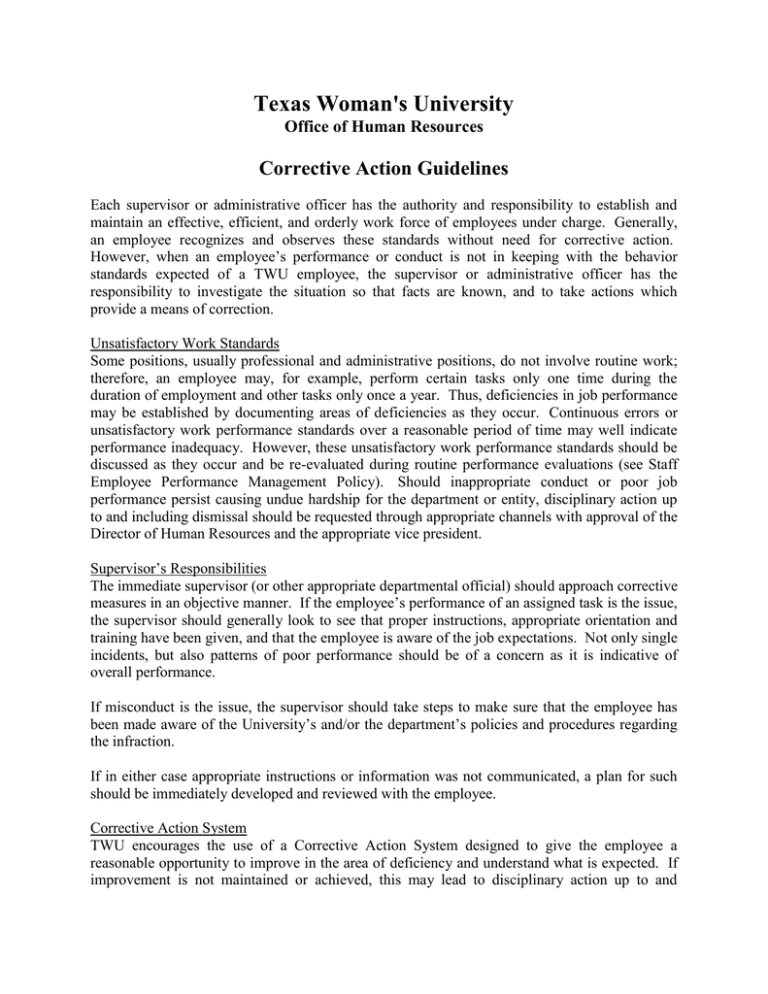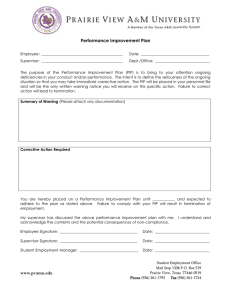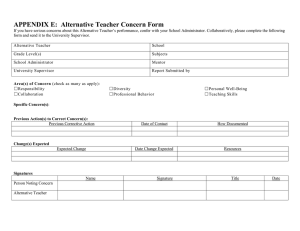Texas Woman's University Corrective Action Guidelines Office of Human Resources
advertisement

Texas Woman's University Office of Human Resources Corrective Action Guidelines Each supervisor or administrative officer has the authority and responsibility to establish and maintain an effective, efficient, and orderly work force of employees under charge. Generally, an employee recognizes and observes these standards without need for corrective action. However, when an employee’s performance or conduct is not in keeping with the behavior standards expected of a TWU employee, the supervisor or administrative officer has the responsibility to investigate the situation so that facts are known, and to take actions which provide a means of correction. Unsatisfactory Work Standards Some positions, usually professional and administrative positions, do not involve routine work; therefore, an employee may, for example, perform certain tasks only one time during the duration of employment and other tasks only once a year. Thus, deficiencies in job performance may be established by documenting areas of deficiencies as they occur. Continuous errors or unsatisfactory work performance standards over a reasonable period of time may well indicate performance inadequacy. However, these unsatisfactory work performance standards should be discussed as they occur and be re-evaluated during routine performance evaluations (see Staff Employee Performance Management Policy). Should inappropriate conduct or poor job performance persist causing undue hardship for the department or entity, disciplinary action up to and including dismissal should be requested through appropriate channels with approval of the Director of Human Resources and the appropriate vice president. Supervisor’s Responsibilities The immediate supervisor (or other appropriate departmental official) should approach corrective measures in an objective manner. If the employee’s performance of an assigned task is the issue, the supervisor should generally look to see that proper instructions, appropriate orientation and training have been given, and that the employee is aware of the job expectations. Not only single incidents, but also patterns of poor performance should be of a concern as it is indicative of overall performance. If misconduct is the issue, the supervisor should take steps to make sure that the employee has been made aware of the University’s and/or the department’s policies and procedures regarding the infraction. If in either case appropriate instructions or information was not communicated, a plan for such should be immediately developed and reviewed with the employee. Corrective Action System TWU encourages the use of a Corrective Action System designed to give the employee a reasonable opportunity to improve in the area of deficiency and understand what is expected. If improvement is not maintained or achieved, this may lead to disciplinary action up to and including dismissal. A Corrective Action System is one in which repeated offenses result in escalating disciplinary action. In order for a corrective action to be effective, it must be consistent, fair, timely, private, progressive and documented. The Director of Human Resources and the department head reserves the right to begin the corrective action process at any step. However, for conduct that is of a nature that is potentially correctable by the employee and not so undesirable as to warrant immediate dismissal, the supervisor, manager, or director should apply one or more of the following steps: Informal Counseling An Informal Counseling session may be adequate to clear up a minor offense and is generally used to establish an understanding of standards expected of the employee. The supervisor should document the date and nature of the Informal Counseling session. Oral Warning If the Informal Counseling Session fails to produce the desired results, the supervisor should progress to an Oral Warning. With an Oral Warning, the supervisor should again discuss the matter with the employee. The Oral warning should be in a written format and a copy should be given to the employee. The Oral Warning will put the employee on notice that failure to correct the problem(s) will lead to further corrective action. The supervisor should maintain a complete and accurate written notation of the Oral Warning. Letter of Corrective Action If the problem continues after the Oral Warning, the supervisor should have a more formal discussion, confirmed by a Letter of Corrective Action, with the employee which details how performance or conduct has failed to meet standards. A copy of the Letter of Corrective Action should be sent to the Office of Human Resources for the official personnel file. The employee may file a letter of comment to the Letter of Corrective Action and a copy will be placed in the employee’s official personnel file. Any such letters of Corrective Action and the employees’ responses to the letters shall become a permanent part of the file. Such letters generally will not be taken into consideration after three years. Letter of Final Warning If the poor work performance or misconduct continues, a Letter of Final Warning should be issued. The supervisor must receive approval from her/his divisional vice president and approval from the Manager of Employee Advocacy and Performance Management in the Office of Human Resources before meeting with the employee. Suspension Without Pay While not required, if the supervisor, or administrative officer, feels that the next step should be a disciplinary suspension without pay, she/he should discuss the matter with the Manager of Employee Advocacy and Performance Management (Manager of EA/PM). With concurrence of the Manager of EA/PM and the appropriate divisional vice president, a disciplinary leave may be imposed. A disciplinary leave without prior reprimand may be justified for offenses which violate major rules of conduct. Dismissal The final action in the Corrective Action Guidelines is dismissal. The supervisor must receive approval from her/his divisional vice president, and the Office of Human Resources prior to the dismissal termination meeting. The supervisor must provide a written request to the Manager of Employee Advocacy and Performance Management stating the reason for the dismissal and a description of the final incident. The Manager of Employee Advocacy and Performance Management will review the request with the Director of Human Resources and communicate a decision to the supervisor (see Dismissal Termination Procedures). Once the appropriate approvals have been received, the supervisor will arrange a dismissal termination meeting with the employee unless otherwise authorized by the Office of Human Resources. A copy of the discharge letter, or other approved letter, should be given to the employee during the dismissal termination meeting. A copy of the letter should be sent to Human Resources for the personnel file.

